2012年04月24日
Italian BCM Extreme .338, .408 and .460 Rifle
私たちのブログを訪問していただきありがとうございます。あなたがお持ちの場合DIYの要求は私達に電子メールを送信してください。
Italian firm BCM Europe Arms was exhibited their Extreme rifle at the Italian gun expo EXA 2012.

The Extreme Rifle is a competition rifle and is chambered in .338 Lapua Mag. (27.5" barrel), .408 Chey-Tac (27.5" barrel) and .460 Steyr (31.8" barrel). The rifle can be produced on request in 6.5x47 Lapua, 6.5/284 Norma and .308 Win.


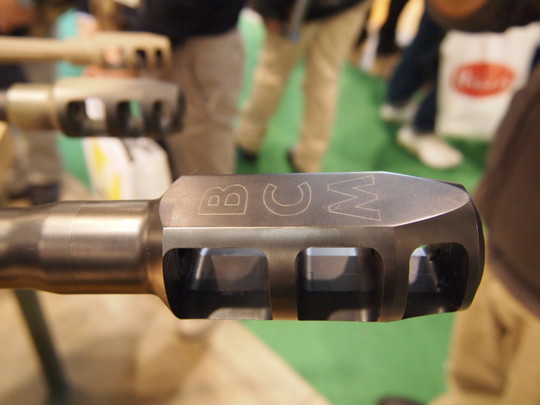


It has a single shot, shell holder style action. The 7.5 lbs stock is machined from a single block of aluminum which can be anodized in a range of colors to suit the customer. The rifles feature large muzzle brakes in a variety of styles.
BLOG ARCHIVES

Italian firm BCM Europe Arms was exhibited their Extreme rifle at the Italian gun expo EXA 2012.

The Extreme Rifle is a competition rifle and is chambered in .338 Lapua Mag. (27.5" barrel), .408 Chey-Tac (27.5" barrel) and .460 Steyr (31.8" barrel). The rifle can be produced on request in 6.5x47 Lapua, 6.5/284 Norma and .308 Win.





It has a single shot, shell holder style action. The 7.5 lbs stock is machined from a single block of aluminum which can be anodized in a range of colors to suit the customer. The rifles feature large muzzle brakes in a variety of styles.
BLOG ARCHIVES

2012年04月22日
Black Rifle Company SASS 6.8 SPC
私たちのブログを訪問していただきありがとうございます。あなたがお持ちの場合DIYの要求は私達に電子メールを送信してください。
Semi Automatic Sniper System boasting tactical advantages through innovation!
When the SASS (Semi Automatic Sniper System) was originally developed as a 7.62×51mm NATO rifle for the U.S. Military. Its intended purpose was to provide a reliable semi-automatic precision rifle in a familiar platform that could be issued on a wider basis. While the bolt rifle has its place, our current area of operation is not always conducive to the lower rate of fire and magazine capacity. It also requires specialty training, as it is a completely different platform. By using what is easily the most familiar rifle platform our troops have, the train-up is far less. There was also the added benefit of magazines and other interchangeable items in inventory from the Mk 11 Mod 0 project.

Black Rifle Company’s SASS is accurate, reliable, and true to the Semi Automatic Sniper System concept, shown here with a Leupold Mark AR scope and GG&G XDS bipod.
Although a typical SASS-style rifle is probably not as pinpoint-accurate as a bolt gun, it is pretty close. Semi-automatic precision rifles have come a long way, and there are several solid versions inspired by this rifle in various chamberings. Priced comparably with many other AR-type rifles that yield precision accuracy, they have become truly versatile systems. It really has opened the platform up to the police world, a world where the semi-auto sniper rifle is still quite rare.

Scoped AR type rifles like the SASS really need an extended charging handle to work properly, allowing it to be operated around the optics.

The high-quality quad rail is perfectly suited to this rifles mission. There was plenty of rail space for accessories yet a nice soft area for precision hand holds from positions other than prone.

A simple birdcage flash suppressor was provided, but other flash suppressors or muzzle brakes are available by request and can be added as necessary.

Leupold’s Mark AR scope is very simple, lightweight and well suited to just about any tactical environment. The glass is clear and the mil-dot reticle remains a favorite of many operators.
By Dave Bahde, Images by Sean Utley
BLOG ARCHIVES

Semi Automatic Sniper System boasting tactical advantages through innovation!
When the SASS (Semi Automatic Sniper System) was originally developed as a 7.62×51mm NATO rifle for the U.S. Military. Its intended purpose was to provide a reliable semi-automatic precision rifle in a familiar platform that could be issued on a wider basis. While the bolt rifle has its place, our current area of operation is not always conducive to the lower rate of fire and magazine capacity. It also requires specialty training, as it is a completely different platform. By using what is easily the most familiar rifle platform our troops have, the train-up is far less. There was also the added benefit of magazines and other interchangeable items in inventory from the Mk 11 Mod 0 project.

Black Rifle Company’s SASS is accurate, reliable, and true to the Semi Automatic Sniper System concept, shown here with a Leupold Mark AR scope and GG&G XDS bipod.
Although a typical SASS-style rifle is probably not as pinpoint-accurate as a bolt gun, it is pretty close. Semi-automatic precision rifles have come a long way, and there are several solid versions inspired by this rifle in various chamberings. Priced comparably with many other AR-type rifles that yield precision accuracy, they have become truly versatile systems. It really has opened the platform up to the police world, a world where the semi-auto sniper rifle is still quite rare.

Scoped AR type rifles like the SASS really need an extended charging handle to work properly, allowing it to be operated around the optics.

The high-quality quad rail is perfectly suited to this rifles mission. There was plenty of rail space for accessories yet a nice soft area for precision hand holds from positions other than prone.

A simple birdcage flash suppressor was provided, but other flash suppressors or muzzle brakes are available by request and can be added as necessary.

Leupold’s Mark AR scope is very simple, lightweight and well suited to just about any tactical environment. The glass is clear and the mil-dot reticle remains a favorite of many operators.
By Dave Bahde, Images by Sean Utley
BLOG ARCHIVES

2012年04月21日
Brugger & Thomet’s APR338
私たちのブログを訪問していただきありがとうございます。あなたがお持ちの場合DIYの要求は私達に電子メールを送信してください。
.338 Lapua Mag anti-personnel rifle for long-range precision!

The folding buttstock is adjustable for length of pull, cheekpiece height and buttpad height. It has an integral monopod and handstop along with two flushcup sling points.
Well, no one will mistake that for a hunting rifle,” I thought, as I took my first look at the Brugger & Thomet’s APR338 .338 Lapua Mag. This gun was conceived and built from the ground up specifically for long-range sniping applications. Matte black, steel and aluminum, without any smooth curves or fancy engraving—it’s all business.
The action is a single rectangular block of steel measuring 9.5×2x1.75 inches. A 9.5-inch Mil-Std-1913 rail is bolted to the receiver with six screws. The rail has 40-MOA of slope built in to extract the maximum possible elevation travel from the standard Schmidt & Bender optic. The rail also sports a flip-up aperture rear emergency backup sight, though I can’t imagine it will ever get much use on this type of rifle. A fully protected bolt stop/release is attached to the left rear with a solid steel pin. The bolt is a three-lug, 60-degree, short throw type. One full inch in diameter with various lightening cuts, the construction seems unique. The bolt head is attached to the bolt body via two large diameter roll pins. The head itself is of conventional design with a plunger ejector and spring-loaded snap over extractor in the top right lug. A long groove a little over 0.25 of an inch wide provides the bolt stop surface as well as the anti-bind rail. This prevents marring of the bolt lug by the bolt stop. An interesting rearward curving bolt handle with a non-metallic ball end is fixed to the rear of the bolt body. The curve places the ball directly above the trigger, making fast bolt work a simple affair. A special tool is provided to take down the firing pin system.

Folding to the left side, the stock latches in both positions via a button seen here above the base of the monopod.
The 27-inch fluted barrel is screwed into the receiver in the conventional manner, but in addition to the flutes there are wrench flats cut into the shank at the receiver junction, which permit a simple vise/wrench combo to remove and replace barrels rather than a special barrel vise. This is unique in my experience, and should make field re-barreling work a little simpler.

The muzzle brake has a threaded section protected by a knurled cap. The suppressor screws on over the brake and seals against a tapered surface, while a folding front sight is built into the brake.
Twist rate is 1-in-11 inches, which will be only just adequate to stabilize 300-grain projectiles. It is of a fairly light Palma-type profile, 0.75 of an inch in diameter at the muzzle and 1.5 inches at the breech. The business end of the barrel is equipped with a large two-vent muzzle brake, which is threaded and has a knurled thread protector permitting attachment of a sound suppressor that goes over the brake vents and seals against a tapered surface. A flip-up front sight is attached, completing the emergency sight system.
The sight base and Mil-Std-1913 rail have small transverse holes that are used to attach the supplied mirage band. Commonplace in competition rifles, I’ve rarely seen one used in the field, though it can prove useful during training sessions, where a number of shots will cause enough barrel heat to distort the sight picture.
By Cory Trapp, Images by Steve Woods
BLOG ARCHIVES

2012年04月19日
Nighthawk Tactical 6.5-.284 RIFLE
私たちのブログを訪問していただきありがとうございます。あなたがお持ちの場合DIYの要求は私達に電子メールを送信してください。
Wily wildcat cartridge and custom platform makes it the Lamborghini of sniper rifles!

If you need a cutting-edge custom precision rifle capable of putting lead on target at 1,000 yards and beyond, the Nighthawk Tactical Rifle in 6.5-.284 should fit the bill superbly.
It seems that just about every tactical rifle built these days is chambered in the ubiquitous .308. I understand the allure of the cartridge from a logistical perspective. It’s everywhere — you can find .308 ammunition at the corner drug store, under the seat of most pick-ups and at just about every law enforcement agency/military organization in the United States of America. While it is easy to find and some of the least expensive ammunition out there, the .308 is a ballistic pig. Compared to some of the other cartridges available to today’s shooter, the .308 is about as aerodynamic as a bowling ball.
Gasp! How dare a gun hack blaspheme our nation’s pet tactical cartridge of choice! I didn’t say that I hated the .308, I’m saying I don’t “love” it. The .308 is a fine choice for short-range work and really offers a lot for marksmen shooting out to 600 meters. The short action is nice for rapid bolt work and the .308 is easy on barrels. However, if you want to shoot farther than 600 meters or so, there are many calibers that would make a better choice. One of my favorites is the 6.5-.284, the cartridge chambered in the Nighthawk Tactical rifle here.
Cartridge Details
The 6.5-.284 started off as a wildcat cartridge from its parent, the .284 Win. Necking the .284 down to 6.5mm proved to be a winning combination for long-range enthusiasts searching for mild recoil, high muzzle velocities and high ballistic coefficients. The 6.5-.284 proved to have all three in spades and has become the darling of serious long-range shooters for almost a decade.
The reason the 6.5-.284 is such an excellent choice for long range shooting is that it combines high muzzle velocity with exceptional ballistic coefficients. The higher the muzzle velocity of a cartridge, the flatter it will shoot. A flat shooting rifle is more forgiving to a sniper who fudges his range estimation because the flatter the trajectory of the bullet means that the bullet flies closer to the sniper’s line of sight. In a perfect world, bullets would fly along the line of sight and we wouldn’t even need to estimate range. Alas, we live in a world of gravity where bullets have to be lobbed to their targets. The less parabolic the lob, the less precise we have to estimate our range. Flatter trajectory is always better. The 6.5-.284 has, on average, a 300 feet per second (fps) faster muzzle velocity than the .308.
Where the 6.5-.284 really makes me weak in the knees is when we start looking at its ballistic coefficient (BC). 6.5mm bullets commonly fired in the 6.5-.284 have ballistic coefficients from .595 - .627. BCs of the .308 hover between .488 and .505. While it might not look like much, the higher BC of the 6.5-.284 offers a tremendous advantage to the long-range shooter. The higher BC bucks the wind better, so the sniper has a greater margin of error with his wind calls. For example, the .308 rifle I was issued when I was in the service would have required 7.6 minutes of correction for a 10 mph wind at 900 meters. This Nighthawk Tactical rifle featured here would have only required 5.6 minutes of correction. As a rule, the more aggressive a correction required to compensate for the wind, the higher a probability of a botched wind call.

Nighthawk Tactical has been making custom 1911s for a long time now and has earned the reputation of being one of the finest manufacturers available. They recently started making tactical rifles and, from what my experience has been with this rifle, they’ll soon be known for their quality custom rifles as well.
By Tom Beckstrand, Images by Ichiro Nagata
BLOG ARCHIVES

2012年04月19日
Savage Model 110 BA .338 LAPUA MAG
私たちのブログを訪問していただきありがとうございます。あなたがお持ちの場合DIYの要求は私達に電子メールを送信してください。
Blasting through barriers when deployed in an over-watch, perimeter security or countersniper operations!

Savage Arms 110 BA in .338 Lapua bridges the gap between the 7.62mm NATO and .50 BMG with an innovative and state-of-the-art bolt action rifle that delivers the goods in terms of both accuracy and terminal ballistics.
Savage has a long history of manufacturing affordable bolt-action rifles that are reliable and accurate. Most often considered a company that manufactures hunting rifles, Savage also offers tactical-style rifles specifically suited to the law enforcement and military community. It’s true that Savage rifles cost a bit less than some of the competition, but Savage has never taken a back seat to any company when it comes to reliability, innovation and accuracy when it comes to their rifles.
The latest tactical offering from Savage is the Model 110 BA, considered the flagship of their Law Enforcement Series. It is available in two chamberings; .300 Win Mag and .338 Lapua Mag.

The 110 BA comes standard with Savage’s amazing AccuTrigger, which broke at exactly 2 pounds every time with no take-up. The center, actuation lever provides just enough resistance as you take up the slack in it to let you know when the trigger will break.
The Savage .338 Lapua is a big rifle. It weighs over 15 pounds and is just shy of 51 inches long. You would have to be on some strong prescription medication to not look at this rifle and have wickedly tactical thoughts. It looks more like something from some commando movie than what you would expect from Savage. The appearance of the rifle was not devised to get your attention; it is the culmination of a variety of features perfectly suited to tactical application and deployment.

The uniquely designed optics rail, exquisite AccuTrigger and oversized tactical-style bolt handle makes the 110 BA .338 Lapua a top-notch precision tactical rifle.
For starters, the 110 BA’s stock is an all-aluminum AccuStock. The forearm is nothing more than an aluminum, U-shaped channel that bolts to the AccuStock where the action is solidly secured both laterally and horizontally. There is so much space around the barrel there is no way the forearm will ever come into contact with it. At the muzzle end of the forearm there are three sling swivel studs; one on each side and one on the bottom.
By Richard Mann, Images by Ichiro Nagata
BLOG ARCHIVES

2012年04月19日
Zel Custom Tactilite .338 Lapua
私たちのブログを訪問していただきありがとうございます。あなたがお持ちの場合DIYの要求は私達に電子メールを送信してください。

Capitalizing on the well-documented field success of the .338 Lapua Mag, Zel Custom offers their Tactilite upper receiver, shown here on a C3 Defense AR lower. The hyper-accurate .338 is proving to possess outstanding anti-personnel capabilities at jaw-dropping ranges in excess of 1,500 meters.
If nothing else, the Global War on Terror has provided an excellent proving ground for testing guns and gear, thus determining what really works. A few weeks before beginning this review, a British Army sniper in Afghanistan set a new long distance sniper record by killing not one, but two enemy combatants at a distance of 8,120 feet (verified with GPS). The previous record, held by a Canadian sniper, was 7,972 feet. What cartridge did the Brit sniper use to break the record? Nope, it wasn’t the .50 BMG — it was the .338 Lapua.
Officially designated by the manufacturer as the “.338 Lapua Magnum,” the cartridge has actually been in the developmental stages since the early 1980’s. The .338 Lapua was spawned at the request of the U.S. Military for a long-range sniper cartridge, with the need for a round to be effective at distances up to 1,500 meters.
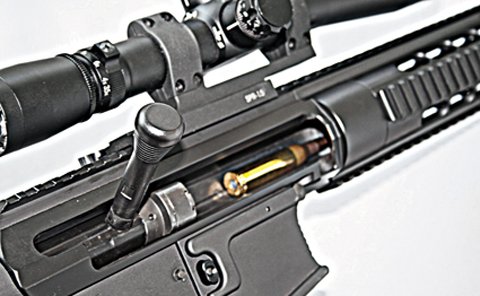
Made from 4340 alloy steel, the Tactilite bolt retracts into the vacant buffer tube. Rounds are loaded singly into breech via a push-feed mechanism.
While it might not have the equipment-crushing power of the .50 BMG, the .338 Lapua using 250- and 300-grain projectiles has serious long-range anti-personnel capabilities. Ballistic coefficient numbers are impressive. The 250-grain BTHP has a 0.61 BC and the 300-grain calculates to 0.73. By comparison the 175-grain .30 caliber BTHP is 0.54 BC. Before getting buried in numbers, it helps to take a look at the hardware.
Question: What is the most versatile rifle available today? Answer: The AR-15 and its myriad clones. Hundreds of thousands of AR variants are in circulation. Dovetailing with the popularity and success of the “black rifle,” Zel Custom Manufacturing is offering specially designed upper receivers in several large rifle calibers.
The initial offering from Zel Custom was the Tactilite T1 in .50 BMG. I had the opportunity to work with one of these rifles last year and found it to be a quality item. Zel surveyed the market and asked the public what caliber they’d like to see next, and the overwhelming response from the public was the .338 Lapua.
By Paul Markel (tactical-life)
BLOG ARCHIVES


Capitalizing on the well-documented field success of the .338 Lapua Mag, Zel Custom offers their Tactilite upper receiver, shown here on a C3 Defense AR lower. The hyper-accurate .338 is proving to possess outstanding anti-personnel capabilities at jaw-dropping ranges in excess of 1,500 meters.
If nothing else, the Global War on Terror has provided an excellent proving ground for testing guns and gear, thus determining what really works. A few weeks before beginning this review, a British Army sniper in Afghanistan set a new long distance sniper record by killing not one, but two enemy combatants at a distance of 8,120 feet (verified with GPS). The previous record, held by a Canadian sniper, was 7,972 feet. What cartridge did the Brit sniper use to break the record? Nope, it wasn’t the .50 BMG — it was the .338 Lapua.
Officially designated by the manufacturer as the “.338 Lapua Magnum,” the cartridge has actually been in the developmental stages since the early 1980’s. The .338 Lapua was spawned at the request of the U.S. Military for a long-range sniper cartridge, with the need for a round to be effective at distances up to 1,500 meters.

Made from 4340 alloy steel, the Tactilite bolt retracts into the vacant buffer tube. Rounds are loaded singly into breech via a push-feed mechanism.
While it might not have the equipment-crushing power of the .50 BMG, the .338 Lapua using 250- and 300-grain projectiles has serious long-range anti-personnel capabilities. Ballistic coefficient numbers are impressive. The 250-grain BTHP has a 0.61 BC and the 300-grain calculates to 0.73. By comparison the 175-grain .30 caliber BTHP is 0.54 BC. Before getting buried in numbers, it helps to take a look at the hardware.
Question: What is the most versatile rifle available today? Answer: The AR-15 and its myriad clones. Hundreds of thousands of AR variants are in circulation. Dovetailing with the popularity and success of the “black rifle,” Zel Custom Manufacturing is offering specially designed upper receivers in several large rifle calibers.
The initial offering from Zel Custom was the Tactilite T1 in .50 BMG. I had the opportunity to work with one of these rifles last year and found it to be a quality item. Zel surveyed the market and asked the public what caliber they’d like to see next, and the overwhelming response from the public was the .338 Lapua.
By Paul Markel (tactical-life)
BLOG ARCHIVES

2012年04月18日
Sako TRG-42 .338 Lapua Mag
私たちのブログを訪問していただきありがとうございます。あなたがお持ちの場合DIYの要求は私達に電子メールを送信してください。
A lightweight and adaptable sniping system that goes beyond 1,750 meters!

Sako’s TRG-42 .338 Lapua Mag gives long-range snipers a highly precise, suppressed bolt-action rifle ready for action. It is topped off with a Schmidt & Bender PM II 5-25×56mm scope.
The sniping caliber of choice for many special operations units today has become .338 Lapua Mag. Incredibly accurate at ¼-MOA or better, sniping rifles in this caliber weigh only a pound or two more than .308 sniping rifles and allow special ops snipers to reach out to more than twice the distance and hit with substantially more power. Since special operators are normally tasked with acting as force multipliers, the advantages of the .338 round are highly valued. The availability of folding stocks for the two or three most popular special ops .338 Lapua rifles allows them be even more portable when deployed from helicopters, small boats, or by foot.
The most widely used .338 Lapua loads can push a 250-grain bullet 2,950 fps (feet per second) and produce 4,800 fpe (foot-pounds of energy). At 1,000 meters, a .338 Lapua bullet could still penetrate five layers of military body armor. Maximum effective range of the round is usually given at 1,750 meters, but it has been used at even greater ranges. Despite being a high-performance sniping cartridge, the .338 Lapua round does not actually cause as much barrel wear as some other cartridges — an important consideration in a sniping rifle, since good snipers practice a lot.

The buttstock is fully adjustable for cheek height, length of pull and pad position. It also contains an integral monopod to complete the support of the rifle for precision shot placement. A simple but rock-solid hinge system locks the folding stock into the extended or collapsed position.
I have now done a reasonable amount of shooting with the four .338 sniping rifles most widely used by special operators and like some aspects of each of them, But Sako’s TRG-42 is truly an outstanding rifle. Many anti-terrorist units around the world use it; among the countries that assign the TRG-42 to their special ops units as their .338 Lapua sniper rifle are Albania, Denmark, Finland, Estonia, Greece, Italy, Russia, Spain, Switzerland, and Turkey.
The .338 Lapua TRG-42 model tested is the OD (Olive Drab/ green), folding stock variant, which is the model used by most units. Black and OD/green fixed stocks are also available. The 27.13-inch tapered, target-grade, chrome moly barrel is cold hammer forged for toughness and accuracy. It has a black phosphate finish. The barrel is threaded for a muzzle brake. Note that the threaded barrel will also take a suppressor. Twist in .338 Lapua is 1-in-12 inches, a rate considered optimum for the 250-grain load used by most military snipers. Overall length with the stock deployed is 49.75 inches and with the stock folded 40.25 inches. Lengths are with muzzle brake installed.

The aggressive muzzle brake helped to tame the felt recoil of the .338 Lapua Mag.
It weighs about 17.5 pounds with the scope and bipod attached, which keeps the TRG-42 portable enough that an operator can transport it into a shooting position quite readily. Note that in comparisons based on published weights for the fixed stock TRG-42, the folding stock version is actually heavier. Yet the TRG-42 is still a couple of pounds lighter than competitive .338 Lapua sniper rifles even with the folding stock.
By Leroy Thompson
BLOG ARCHIVES

2012年04月17日
G.A. Precision 6.5 Creedmoor
私たちのブログを訪問していただきありがとうございます。あなたがお持ちの場合DIYの要求は私達に電子メールを送信してください。
Maximizing the cartridge’s effectiveness for all tactical sniper applications!
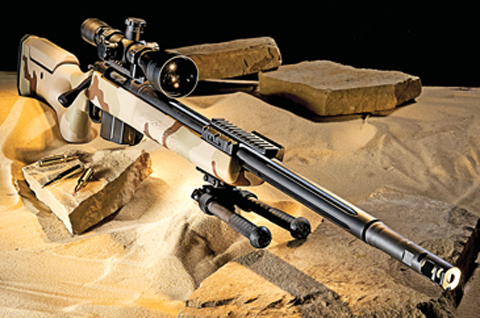
The G.A. Precision rifle is based on a Remington 700-style action in 6.5 Creedmoor caliber and has all of the features wanted in a tactical-grade precision rifle, including a SureFire compensator/suppressor adapter and Manners composite stock.
A new generation of long distance rifles is cropping up that are designed to perform from 500 to 1,000 yards. Optics companies are acting on this trend, offering new scopes that give the shooter clarity of vision at these extended ranges while staying light and compact. Ammunition companies are not sitting back either, developing cartridges that will shoot flat at these long distances and giving riflemen ammo that will meet the challenges presented by these new guns and glass. One of these new cartridges is the 6.5 Creedmore round, developed by the Hornady Ammunition Company. This light but fast round is designed for 500 meters plus and is catching the attention of precision riflemen nationwide.
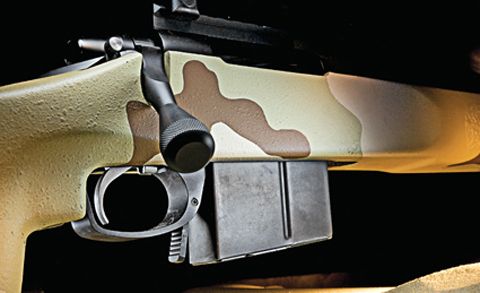
The Templar bolt features one-piece solid construction with an M16-style extractor milled and fit into place to enhance extraction and ejection. Upon opening the bolt primary extraction is increased by 35%, which makes for a very smooth bolt cycle.
Cartridge Details
The first production cartridge ever developed from the ground up to be a true match cartridge is now being loaded with Hornady components, with the potential to become the true modern rifleman’s cartridge. Developed to give competitive shooters a factory-loaded cartridge that will allow them to compete and win at the highest levels of shooting, the 6.5 Creedmoor is making its way into the tactical and hunting worlds. Chambered by several manufacturers of rifles, the 6.5 Creedmoor is making its debut as a hunting or tactical round in Hornady’s new “Superformance” line of ammunition. Loaded with both 120- and 140-grain GMX bullets, the 6.5 Creedmoor brings a level of precision to long distance rifle shooting that is currently unmatched. In addition, its light recoil makes it very easy to shoot for extended periods and is perfect for any North American game, up to and including elk. Of course, it could also be an excellent choice for law enforcement or military operations requiring both short and long distance shots.

The Templar bolt features one-piece solid construction with an M16-style extractor milled and fit into place to enhance extraction and ejection. Upon opening the bolt primary extraction is increased by 35%, which makes for a very smooth bolt cycle.
“Moon” built my test rifle himself using a receiver from G.A. Precision called the short action “Templar,” which accepts Accuracy International AW double-stack magazines. These magazines have plenty of interior space, an asset that reloaders will appreciate. The Templar bolt is one-piece solid construction with an M16-style extractor milled and fit into place to enhance extraction and ejection. Primary extraction is increased by 35% — which means that upon opening the bolt, the case is pulled out of the chamber 35% more upon opening, making for a very smooth bolt cycle. This modification is in both the receiver and bolt. The receiver body is hardened 416 stainless steel and is radiused so it still fits a Model 700-style stock. The recoil lug is precision-ground and double pinned, while the bolt stop has been changed to the G.A.P. Style side release. The bolt/handle is now one piece, machined from a solid piece of 4320 CM and heat-treated. The knob itself is the only part that is threaded. The handle is slanted to the rear and not straight for ease of operation and is nicely checkered for a solid grip while cycling the action.
The stock used for the test gun is a Manners Composite model # T5A with thumbhole, which was given a desert camouflage design by Todd Jackson at Manners. The stock features a KMW cheekpiece insert so the shooter can set their cheekweld as desired. The T5A version is designed as a right hand grip with a small thumb rest on the left side of the stock. Although the T5A version is a right hand stock, it was designed so a left hand grip could also be obtained. A lot of time went into the design of the grip on this stock, as it moves the shooting hand down and forward so the trigger finger is in a more natural position and not having to over-reach for the trigger face. The area behind the trigger looks odd but it is designed to make the hand return to the same spot each time the stock is gripped. It works well with all sizes of hands and comes with a fixed 1-inch Pachmayr Decelerator recoil pad, however, it can also be ordered with the optional butt spacer system with a half-inch Decelerator pad. The standard weight for the T5A is four pounds.

The barrel used was a Bartlein, 26-inch stainless steel unit with a #14 contour, a 1-in-8.5-inch twist and full fluting. It was coated in black CeraKote, as were all of the exposed metal parts used. The bore diameter is .256 with a groove depth of .264. The stock is pillar bedded with aluminum and set with marine-tex epoxy. The barrel is floating approximately 0.19 of an inch and has a 1.5-inch barrel pad. The forward end of the stock has a dual Picatinny rail attached for optional accessories. The triggerguard/magazine housing is the model M5 from Badger Ordnance. A heavy-duty guard that allows quick loading/unloading via a 10-round, double stack magazine utilizes a time-proven paddle-style magazine release. The guard includes grade 5 torx screws and pre-made bedding pillars to guarantee exact fit and perfect function. Made from aircraft-grade aluminum and hard coat anodized black, the guard with an empty 5-round magazine weighs 10.2 ounces.
While no precision rifleman can always count on being able to use a bipod, having one on such a rifle is essential. G.A. supplied this rifle with an Atlas precision bipod Model BT10, which has 15 degrees of pre-loaded pan and cant with four leg positions and an elevation radius of 5 to 9 inches. Standard two-screw clamp-on style is standard and the unit is made from T6061 Aluminum. Hard anodized black stainless steel springs and fasteners are also used. Non-orientated leg positioning allows either hand to move legs into any of the four leg positions: stowed back, 90 degrees straight down, 45 degrees forward and stowed forward. All leg positions are solid, allowing the shooter to load the bipod at the 45- and 90-degree positions, and the durable rubber feet are suitable for many surfaces.
G.A. uses Badger Ordnance scope rings, which are machined from steel bar stock as serialized matched pairs. This assures both rings are identical and eliminates the damaging effects of mismatched, mass-produced rings.
Maximized rings are designed to fit Picatinny optical rails and are finished with mil-spec black oxide. All the hardware on their rings is designed to exact specifications, including the torx screws that hold the scope securely in the rings.
The threaded SureFire suppressor adapter was added to the barrel and also functions as a high-performance muzzle brake when the suppressor is removed. The patented design greatly diffuses side blast, fights against up/right muzzle movement to help stay on target and eliminates felt concussion back at shooter. Made with heat-treated stainless steel construction, the SureFire adapter provides rock-solid suppressor attachment in seconds without tools.

The Leupold Mark 4 4.5-14×50mm scope offers high resolution and maximum light gathering capability with parallax adjustment and ¼” clicks for windage and elevation.
A precision rifle without a scope is like an airplane without wings. For the precision bolt gun to be its best, it needs a quality optic to search, identify and zero in on targets. It is not unusual to spend just as much, if not more, on the optic as the rifle. In the case of this gun, I used a Leupold Mark IV 4.5-14×50mm ER/T scope. Like all things Leupold, the scope is solidly built with everything one would want in a tactical-grade optic. The Mark IV 4.5-14 has a number of worthwhile features, including the Leupold Index Matched Lens System, which delivers superior resolution from edge to edge of the optic’s visual field, even at 14 power, along with peak image brightness and optimal contrast. In addition, a side-focus parallax adjustment is standard for fast, easy parallax focusing from 50 yards to infinity. M1 windage and elevation adjustment dials with audible, tactile ¼-MOA clicks make adjustment easier under any lighting conditions. The reticle is magnified along with the image, so the shooter can estimate range at any magnification. Available in a durable, subdued matte black finish, the Mark IV 4.5-14 is absolutely waterproof.

The stock features a fully adjustable KMW cheekpiece insert so that shooters can set their cheekweld as desired.
By Dave Spaulding, Images by Sean Utley
BLOG ARCHIVES

2012年04月16日
Kimber M8400 Advanced Tactical Rifle .308
私たちのブログを訪問していただきありがとうございます。あなたがお持ちの場合DIYの要求は私達に電子メールを送信してください。
Enhanced features and capable of sub-MOA performance!

Given the commitment that Kimber has made to provide law enforcement and civilian shooters with top-grade 1911 pistols for duty and defense, it was no surprise when Kimber announced it was entering the tactical rifle market in January 2007. The Yonkers gunmaker currently catalogs three rifles of this type: the M84 LPT (Light Police Tactical), made on the company’s Model 84 action, the Tactical and Advanced Tactical guns, both based on the larger Model 8400 action. All differ in weight, barrel length and stock options.
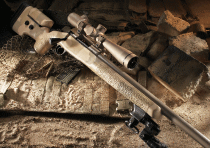
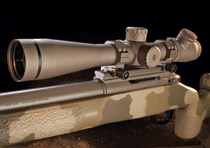
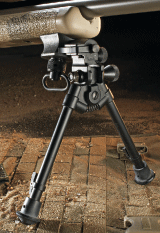

By Stanton Wormely, Jr., Images by Steve Woods
BLOG ARCHIVES

2012年04月15日
Halo Arms Maximus .50 BMG
私たちのブログを訪問していただきありがとうございます。あなたがお持ちの場合DIYの要求は私達に電子メールを送信してください。
Ultimate hybrid system, competition accuracy with military ruggedness, bringing down hardened targets!

A .50 BMG rifle is an essential law enforcement tool, and the Halo Maximus has some unique features that set it apart from most other .50 BMG rifles. The Maximus is manufactured almost entirely of aluminum alloy and steel, which comprises the barrel, receiver, bolt, fire control components and a few other elements.
When police special tactical units are evaluated by the Department of Homeland Security, the presence or absence of a .50 BMG (Browning Machine Gun) caliber precision rifle is a critical rating factor. While a .50 BMG caliber rifle may seem to be overkill in an urban or even rural environment, there are scenarios in both environments when nothing else will do. Subjects barricaded behind barriers that are impervious to smaller caliber firearms can be defeated with a .50 caliber rifle. For instance, situations where terrorists have taken over the cockpit of an airliner can be alleviated only by using a .50 caliber rifle, since the windscreens of commercial jet aircraft are designed to resist impacts much like those of smaller caliber rifle bullets. In facilities where bullet-resistant glass is present, such as banks, only a .50 BMG caliber rifle can eliminate threats.
Thus, while some might consider a .50 BMG rifle unnecessary in law enforcement, the opposite is true. A .50 BMG rifle is an essential law enforcement tool. Although situations calling for a .50 BMG caliber rifle are relatively rare, when a situation occurs where a .50 BMG caliber rifle is necessary, it is too late to have a SWAT team precision tactical marksman qualified in the use of the big rifle. Unlike the famous LA Shootout where officers borrowed semi-automatic small caliber rifles from sporting goods stores, .50 BMG rifles aren’t very common, even in gun stores. In addition, if a situation arises where a .50 BMG rifle is to be employed, the responsible team member must be thoroughly qualified to use it and must maintain his proficiency so that when the worst happens, the team .50 BMG rifle can be employed without fear of legal repercussions due to training or proficiency issues.

The Halo Maximus uses a BAT Machine receiver and locks via two massive lugs at the front, spaced opposite from each other. The bolt handle can be considered as safety lug, and the Maximus’ bolt operation was butter-smooth right from the box.
Because a firearm without ammunition is no more than a very expensive club, this is another factor in the use of a .50 BMG rifle since ammunition of various types has decidedly different characteristics. All .50 BMG ammunition is capable of defeating targets that would withstand even the most potent bullets of smaller calibers, but the team leader must choose his ammunition with just as much care as he did the team rifle. Commonly available .50 BMG ammunition includes M2 and M33 ball, M2 armor-piercing (AP), M8 armor-piercing incendiary (API), armor-piercing match from Anthena and plain commercial match ammunition. Mark 211 API is also available to law enforcement, but this most potent API has behind target incendiary effects that probably aren’t desirable for law enforcement purposes.
Of commercially available US military ammo, M8 API is generally considered to be the most accurate, although if used operationally, the incendiary effect must be taken into consideration. The Army has begun purchasing a match-grade round for its M107 rifles. This round is currently designated the XM1022 and is made by Lake City Army Ammunition Plant. The design is similar of the Anthena armor piercing ammunition tested herein, but without the armor-piercing penetrator. I recommend match-grade ammunition that will defeat hard targets. For tough targets, Anthena AP match ammunition imported by Drake Associates probably represents the best balance of accuracy and terminal effects, although it is expensive. I have fired Anthena AP Match bullets against inch-thick armor steel at 300 meters distance and not only did every round penetrate with enough behind armor effect to be lethal, the three-round groups we fired could be covered with the palm of our hand. In one group, two rounds were actually touching. The Anthena AP has been ordered in large quantities (over 5,000 rounds) by a major U.S. police department for harbor protection and is in use by several federal law enforcement agencies.

The Halo Maximus’ weight is one factor that contributes to the lack of felt recoil, but more important is the rifle’s aggressive muzzle brake, which counters recoil by essentially pulling the rifle forward as the bullet leaves the muzzle.
When it comes to rifles suitable for law enforcement use against hard targets, the selection is limited. One of these is the Halo Arms Maximus, which is a large rifle—but when dealing with a cartridge that launches a half-inch diameter bullet weighing as much as 750 grains at nearly 3,000 feet per second (fps), the rifle that shoots it is also going to be big—and heavy. The Maximus is nearly 5 feet in length with a standard 30-inch chrome molybdenum steel barrel. A carbine version with 22-inch barrel is also available.
By Charlie Cutshaw, Images by Doug Richardson
BLOG ARCHIVES

2012年04月12日
Weatherby Mark V TRR Custom .300 Win Mag
私たちのブログを訪問していただきありがとうございます。あなたがお持ちの場合DIYの要求は私達に電子メールを送信してください。
Tactical Response Rifle — cold bore zero, repeatable accuracy and reliability!
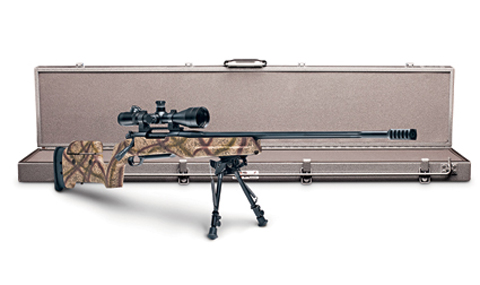
The deep barrel channel ensures clearance between stock and barrel allowing for easy cleaning, verification nothing is touching barrel, and aids in cooling down the barrel. The barrel fluting and Teflon finish are also shown. The ATN PS22 Night Vision device is attached via scope connector to the Leupold’s 50mm objective.
While Weatherby hunting rifles are well known and respected, their entry into the tactical bolt-action market is relatively unknown. Yet any precision shooter would be comforted to know about the Mark V SUB-MOA Threat Response Rifle (TRR) Custom offered in .300 Win Mag, .300 Wby, .30-378 Wby, and .338-378 Wby. The TRR comes with a Weatherby guarantee to shoot three-shot groups at a minimum a 0.99 of an inch or less when using premium factory ammunition. Weatherby has chosen to go a different path with the TRR by balancing accuracy, weight, and enhanced cartridge capability compared to the heavyweight .308 offerings or larger tactical rifles. The TRR handles as if you could carry it for lengthy amounts of time and still be able to take a non-prone shot if the mission dictates.
There are different shooting disciplines—target, sport, hunting, tactical, etc. Each discipline dictates its own performance parameters. Each parameter generates different priorities on design. Many of the same desirable characteristics for a tactical rifle crossover into multiple disciplines—cold bore zero, repeatable accuracy, effective range, reliability, and handling. Tactically, when not only the shooters life is at stake, but also others such as teammates or innocent hostages, there can be no compromise in terms of consistent accuracy from 100 yards to 1,000 yards. The high-pressure tactical environment is a demanding proving ground from which other shooting disciplines can benefit.

D.D. Ross designed tactical-style bolt handle provides additional length and weight to improve grasp and handling.

A rail is embedded under the length of the forearm allowing for multiple studs for mounting bipod, sling, or other accessories. Nice attention to detail on a tactical rifle.
The TRR features a hinged floorplate with 3+1 capacity. The stock was a Desert camouflage pattern, with various stocks also available. The TRR follows the proven accuracy equation of other Weatherby rifles—Mark V action, Krieger barrel, tuned trigger, and Bell & Carlson composite stock. The Bell & Carlson stock on the TRR is significantly modified to excel in the tactical realm with multiple adjustments allowing a law enforcement marksman to custom fit it to individual needs. The Weatherby Custom Shop offers optional features such as a D.D. Ross-designed bolt handle, extended drop box magazine with an extra round capacity, and a more aggressively designed muzzle brake. A Mark V SUB-MOA TRR package includes a Leupold Mark 4 4.5-14×50mm scope, Talley Mil-spec rings/bases, Harris Model L bipod and aluminum rifle case.
By Todd Burgreen
BLOG ARCHIVES

2012年04月08日
Next Gen Squad DMRs
私たちのブログを訪問していただきありがとうございます。あなたがお持ちの場合DIYの要求は私達に電子メールを送信してください。
Sub-MOA accurate Designated Marksman M14s for 800-yard engagements!
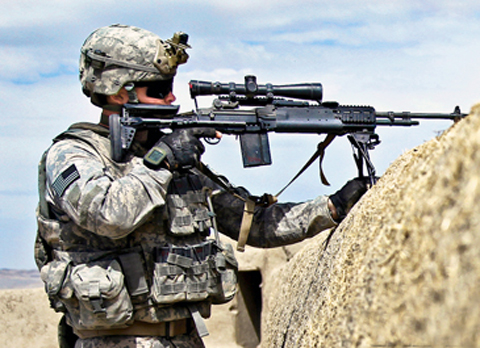
The ideal platform for a trained Designated Marksman, the EBR system includes a Leupold optic, six magazines and field maintenance gear.
Imagine a rifle and its attendant training so good that Taliban forces have been forced to modify their tactics. The Designated Marksman program was officially implemented in 2003 by the U.S. Army and has been in high demand ever since. A Designated Marksman is trained to deliver precise, long-range rifle fire out to around 600 yards. Unlike a sniper, DMs maneuver with their squad as normal and can be tasked with long-range shooting and overwatch as needed. Much like the Combat-Lifesaver program, this additional training extends the ability within a squad.
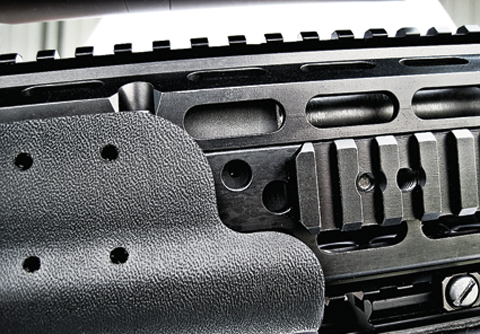
The operating rod guide block makes the M14 barreled action into a monolithic unit.
As implemented, the Designated Marksman program and qualification calls for as-issue rifles, either an M16A2 with iron sights or M16A4 with optics. Effective long-range shooting is more about marksmanship and know-how than equipment. Issued M16s shooting 5.56mm ball are more than capable of getting consistent hits a half-kilometer away, but enhanced gear helps. Purpose-built M16-based Designated Marksman Rifles made by the Army Marksmanship Unit have been fielded with good results and help make getting those hits easier.
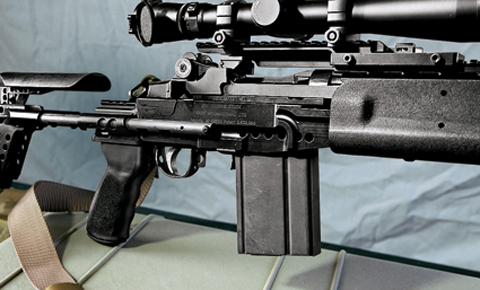
To date, over 6,200 EBRs have been fielded, more than the M110, AMU-built DMR and M24 sniper rifles combined.
A potential problem, especially at extended distances, is the lack of “oomph” the 5.56mm cartridge offers. DMs are charged with engaging enemy targets out to 500 meters and standard-issue rifle ammunition might not cut it. Increasing to 7.62mm potentially affords greater range. It certainly hits harder. While training some of the first units deploying to Iraq in 2004 at Fort Hood, we had many soldiers assigned as Designated Marksmen being outfitted with M14s. While this took care of the power issue, these were simply rack-grade M14 rifles with a mix of aftermarket bolt-on bases and optics.

The Sage stock includes a barrel whip control screw that minimizes barrel vibration and improves accuracy.
By John M. Buol, Jr.
BLOG ARCHIVES

2012年04月05日
McMILLAN M3A 7.62mm
私たちのブログを訪問していただきありがとうございます。あなたがお持ちの場合DIYの要求は私達に電子メールを送信してください。
M14 modernized to handle any threat — at close range or at a distance!

The McMillan stock and Troy M14 Modular Battle Rail sporting a Nightforce 2.5-10×24 scope transform the M1A Squad Scout into a modern rifle ready for use against threats hiding behind barriers or at ranges beyond those where the AR-15 is effective.
Some shooters have a spiritual attachment to the M14, the battle rifle that followed the M1 Garand and had a short-lived run as the U.S. infantry’s small arm. It was replaced by the M16 to the dismay of many and the delight of others, but even some of those who eschewed the M14 and its 7.62mm round have now recognized their value because of the battle needs in Afghanistan, where killing power at longer distances is often needed to defeat the enemy. Consequently, the military has dusted off many old armory M14s and pressed them into service once again.

Often law enforcement is influenced by small arms trends in the military and it would not be surprising to see certain agencies express interest in fielding the M14 or the civilian equivalent M1A for special applications. The threat of a terrorist attack is ever-present and could involve targets hiding behind barriers or at longer ranges where the power and reach of the 7.62mm cartridge has an advantage over the M16’s smaller 5.56mm round. In those cases, a weapon that has more power to penetrate vehicles or cover, is effective at 800 yards or more, can fire semi-automatic and handles well in enclosed areas under close combat conditions could be a very valuable addition to the law enforcement arsenal.

The McMillan M3A was equipped with a Nightforce NXS 2.5-10×24mm scope, but the rail will accept about any aiming device. Note that the rail eliminates the rear aperture sight that is standard on M1As.
There is no doubt that the M14 is dated, at least in its ability to serve as a platform for accessories such as optics, laser aiming devices and illumination tools. There just isn’t any place to mount them. When the receiver was designed so many years ago, the average infantryman for whom the gun was created used iron sights, and no consideration was given to supplying him with an optic. Such devices were reserved for snipers, who of course used bolt actions. Therefore, little or no thought was given to building a receiver that could readily accept a scope.
By Doug Larsen
BLOG ARCHIVES

2012年04月03日
M1 Garand EBR Tactical Stock System
私たちのブログを訪問していただきありがとうございます。あなたがお持ちの場合DIYの要求は私達に電子メールを送信してください。
A lot of people will disagree with me, but I like Sage EBR Tactical Stock Systemfor the M1 Garand. It is a drop-in stock that does not require permanent modifications to the rifle.
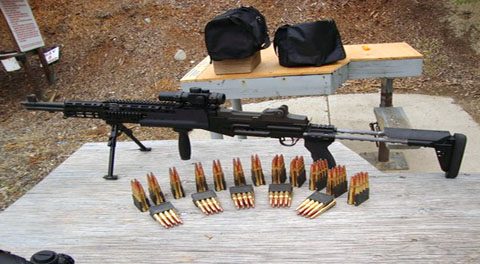
From thefirearmblog
BLOG ARCHIVES

A lot of people will disagree with me, but I like Sage EBR Tactical Stock Systemfor the M1 Garand. It is a drop-in stock that does not require permanent modifications to the rifle.

From thefirearmblog
BLOG ARCHIVES

2012年04月02日
98 Bravo Mountain Warfare Machine
私たちのブログを訪問していただきありがとうございます。あなたがお持ちの場合DIYの要求は私達に電子メールを送信してください。
Barrett’s handy .338 LM gives sub-MOA bite out to 1,500 YDS less the BMG kick!

Generally speaking, I test somewhere between a dozen and two-dozen new rifles a year, and of that number there are usually a couple that I anticipate with special interest. For some time, the rifle I have anticipated the most has been the Barrett 98 Bravo. The overall quality and accuracy of Barrett rifles is well known, and I have friends in numerous special operations or counter-terror units who consider their Barrett “50s” among their most effective tools. I agree entirely, having fired Barrett .50 BMG rifles and been very impressed. However, my favorite long-range round is the .338 Lapua, which offers an operator the ability to range out to at least 1,200 to 1,500 yards in the antipersonnel role and still be effective in the anti-materiel role against many hard targets.

The Barrett 98 actually started its life as a semi-auto back in 1998, but never went into full production. Ronnie Barrett’s son Chris revived the 98 project as a bolt gun. Steve Woods Photo
Very important for operators who may be inserted into their AO (Area of Operations) then have to climb or walk to their shooting position, .338 Lapua rifles are generally more portable. They are still not as light as a typical M4, though I have seen M4s with so much gear added that they might be approaching the weight of some .338 Lapua rifles. But a .338 Lapua rifle may be easily humped into action—in fact, some special ops units have made the .338 their default sniping round instead of the .308 or .300 Win Mag.

This view from behind the 98 Bravo illustrates how easy it is to see the screen of the BORS while maintaining a shooting position. For maximum comfort and speed, the ergonomic grip pairs well with the hefty bolt knob.
Barrett’s 98 Bravo is an excellent platform for the .338 Lapua round. Unlike many other .338 Lapua rifles that are based on sporting rifles, the 98 Bravo was designed from the beginning as a tactical rifle. As a side note, this is the case with the .338 Lapua cartridge as well, which was purpose-designed as a long-range man-killer. Development began on the 98 Bravo over a decade ago, but it wasn’t until recently that the rifle was considered fully ready for deployment with military and law enforcement tactical units. Speaking of law enforcement units, there are some—especially units such as the FBI HRT or state police tactical units—that may be deployed in areas where very long shots might be required. Because of the words “Machine Gun” in the designation, a .50 BMG (Browning Machine Gun) rifle might be harder to sell to administrators than would a .338 Lapua.

A sniper team can do some anti-materiel damage with the .338 LM. The spotter can quickly call the shots for the sniper, allowing him to adjust for a follow-up shot.
By Leroy Thompson
BLOG ARCHIVES

2012年03月31日
LAR Grizzly T-50 .50BMG
私たちのブログを訪問していただきありがとうございます。あなたがお持ちの場合DIYの要求は私達に電子メールを送信してください。

The LAR Manufacturing Grizzly T-50 is a beast. Designed to be capable of being shoulder fired, it was no accident that a muscular guy was manning the booth of this .50 BMG single shot bullpup. At its shortest barrel length, 32", it weighs in at 30.4 pounds, and thats without a scope, bipod, rails and carry handle!

LAR Grizzly T-50 .50BMG mounted on tri-pod
From thefirearmblog
BLOG ARCHIVES

2012年03月22日
Iron Ridge Arms IRA-X THOR 7.62mm
私たちのブログを訪問していただきありがとうございます。あなたがお持ちの場合DIYの要求は私達に電子メールを送信してください。
High-speed, low-drag AR-10-style rifle with repeatable sub-MOA precision!
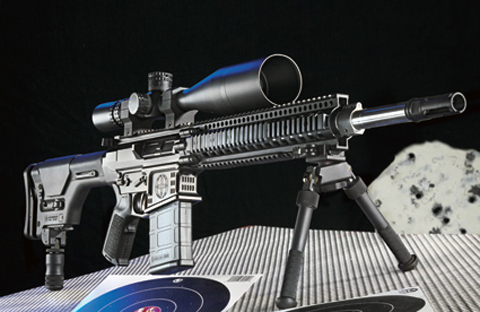
Iron Ridge’s IRA-X family of rifles focuses on getting the important stuff right. The result is a truly exceptional and customizable AR-10-style rifle with all the attention to detail to make it a precision powerhouse. To get the most out of the IRA-X Thor, a Nightforce NXS 5.5-22×56mm scope was mounted.
When it comes to succeeding in a tactical environment, most experts will agree that it ultimately comes down to a matter of doing the basics better. “High-speed, low-drag” doesn’t mean complicated or advanced; it means the ability to perform critical tasks flawlessly under any circumstances—in short, getting the important stuff right. While that wisdom is certainly valid when it comes to tactical skills, it is equally applicable to equipment manufacture. And getting the important stuff right is what Iron Ridge Arms’ IRA-X AR-10-style rifles are all about.
Iron Ridge Arms is a manufacturer and custom shop that specializes in Class II and Class III firearms. Nestled discreetly in an industrial park in Longmont, Colorado, it is owned and operated by veteran gunsmith, machinist and designer Oliver Mazurkiewicz. Through his many years of experience customizing and modifying all brands of tactical rifles and carbines, Mazurkiewicz developed a keen understanding of the critical qualities necessary in that breed. And while many manufacturers do an excellent job of providing these qualities, as a custom gunsmith, Mazurkiewicz always saw room for improvement. He believed that if that extra attention to detail were incorporated into the fundamental construction of the rifle, its “basics” would literally be as good as they could get.
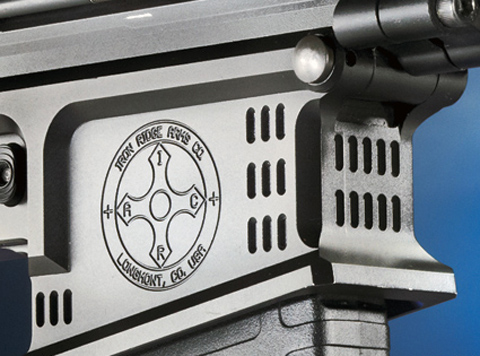
Starting with the right foundation—the IRA-X has meticulously machined upper and lower receivers that are fitted perfectly to withstand the harshest conditions.
The core of the IRA-X is its meticulously machined upper and lower receiver. Designed and engineered to meet Mazurkiewicz’s exacting specifications, these parts are CNC-machined from solid billets of 7075-T6 aluminum in the Iron Ridge shop. Although they are designed to accept components purchased from DPMS, which Mazurkiewicz has carefully selected as “the standard” of quality and consistency for drop-in parts, they are not your run-of-the-mill receivers.
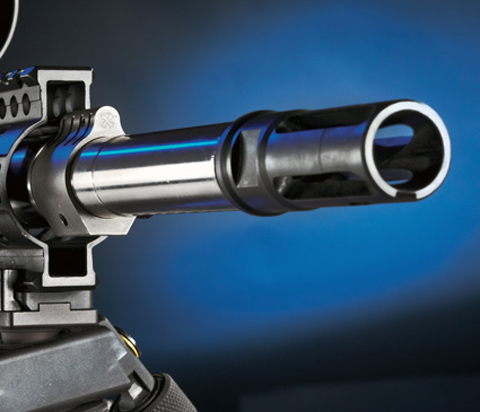
The IRA-X Thor tested for this article featured a custom-machined Rock Creek barrel fitted with a SureFire FH762K03 flash suppressor.
By Michael Janich. Images by Steve Woods
BLOG ARCHIVES

High-speed, low-drag AR-10-style rifle with repeatable sub-MOA precision!

Iron Ridge’s IRA-X family of rifles focuses on getting the important stuff right. The result is a truly exceptional and customizable AR-10-style rifle with all the attention to detail to make it a precision powerhouse. To get the most out of the IRA-X Thor, a Nightforce NXS 5.5-22×56mm scope was mounted.
When it comes to succeeding in a tactical environment, most experts will agree that it ultimately comes down to a matter of doing the basics better. “High-speed, low-drag” doesn’t mean complicated or advanced; it means the ability to perform critical tasks flawlessly under any circumstances—in short, getting the important stuff right. While that wisdom is certainly valid when it comes to tactical skills, it is equally applicable to equipment manufacture. And getting the important stuff right is what Iron Ridge Arms’ IRA-X AR-10-style rifles are all about.
Iron Ridge Arms is a manufacturer and custom shop that specializes in Class II and Class III firearms. Nestled discreetly in an industrial park in Longmont, Colorado, it is owned and operated by veteran gunsmith, machinist and designer Oliver Mazurkiewicz. Through his many years of experience customizing and modifying all brands of tactical rifles and carbines, Mazurkiewicz developed a keen understanding of the critical qualities necessary in that breed. And while many manufacturers do an excellent job of providing these qualities, as a custom gunsmith, Mazurkiewicz always saw room for improvement. He believed that if that extra attention to detail were incorporated into the fundamental construction of the rifle, its “basics” would literally be as good as they could get.

Starting with the right foundation—the IRA-X has meticulously machined upper and lower receivers that are fitted perfectly to withstand the harshest conditions.
The core of the IRA-X is its meticulously machined upper and lower receiver. Designed and engineered to meet Mazurkiewicz’s exacting specifications, these parts are CNC-machined from solid billets of 7075-T6 aluminum in the Iron Ridge shop. Although they are designed to accept components purchased from DPMS, which Mazurkiewicz has carefully selected as “the standard” of quality and consistency for drop-in parts, they are not your run-of-the-mill receivers.

The IRA-X Thor tested for this article featured a custom-machined Rock Creek barrel fitted with a SureFire FH762K03 flash suppressor.
By Michael Janich. Images by Steve Woods
BLOG ARCHIVES

2012年03月19日
Wilson Combat Tactical Hunter
私たちのブログを訪問していただきありがとうございます。あなたがお持ちの場合DIYの要求は私達に電子メールを送信してください。

Tactical Hunter, 18”or 20"
• Forged 7075 Upper (Flat Top) and Lower Receiver
• Wilson Combat Tactical Hunter Match Grade Barrel with 6 Groove / 1:12 Twist (Conventional or Polygonal Rifling) or Noveske Polygonal 1:11 Twist (all with M4 feedramps)
• Mid Length Gas System with Lo-Profile Gas Block
• 18" or 20" with Crowned Muzzle or 18" with Threaded Muzzle (5/8 x 24) with Accu-Tac Flash Hider
• Wilson Combat T.R.I.M. Rail - 10.4" on 18" Barrels, 12.6" on 20" Barrels
• Ergo Pistol Grip
• Wilson Combat Tactical Triggerguard
• Rogers/Wilson Super-Stoc
• Wilson Combat TTU (Tactical Trigger Unit) Two-Stage, 4#
• Premium Mil-Spec Bolt and Bolt Carrier, MP Inspected, NP3 Coated
• Mil-Spec Hard Anodize Finish on Upper / Lower Receivers
• Armor-Tuff® Finish
• 20 Round Modified Lancer L5 AWM Magazine




NEWS ARCHIVES


Tactical Hunter, 18”or 20"
• Forged 7075 Upper (Flat Top) and Lower Receiver
• Wilson Combat Tactical Hunter Match Grade Barrel with 6 Groove / 1:12 Twist (Conventional or Polygonal Rifling) or Noveske Polygonal 1:11 Twist (all with M4 feedramps)
• Mid Length Gas System with Lo-Profile Gas Block
• 18" or 20" with Crowned Muzzle or 18" with Threaded Muzzle (5/8 x 24) with Accu-Tac Flash Hider
• Wilson Combat T.R.I.M. Rail - 10.4" on 18" Barrels, 12.6" on 20" Barrels
• Ergo Pistol Grip
• Wilson Combat Tactical Triggerguard
• Rogers/Wilson Super-Stoc
• Wilson Combat TTU (Tactical Trigger Unit) Two-Stage, 4#
• Premium Mil-Spec Bolt and Bolt Carrier, MP Inspected, NP3 Coated
• Mil-Spec Hard Anodize Finish on Upper / Lower Receivers
• Armor-Tuff® Finish
• 20 Round Modified Lancer L5 AWM Magazine




NEWS ARCHIVES

2012年03月17日
Barrett MRAD
私たちのブログを訪問していただきありがとうございます。あなたがお持ちの場合DIYの要求は私達に電子メールを送信してください。
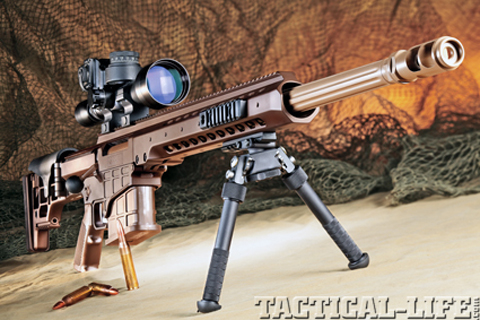
Multi-Role Adaptive Design rifle (MRAD)
Ready to follow your every move, the MRAD adapts to a variety of user needs without sacrificing performance. With unrelenting precision and unfailing accuracy, this bolt action newcomer has already defined a whole new class of long-range rifles.
The MRAD rifle’s user-changeable barrel system is just one example of this hardworking gun’s modularity. The precision-grade barrel can be removed by simply unscrewing two bolts using a standard Torx wrench. Besides reducing maintenance and logistical burdens, this unique design paves the way for future caliber interchangeability and serviceability.
The MRAD also boasts Barrett’s new easily accessed trigger module. This match-grade trigger is drop-fire-proof and combat-ready. The thumb-operated safety can be configured for left or right hand operation. The ambidextrous magazine release can be used intuitively while retaining a firing grip and cheek weld.



Integrated into the MRAD rifle’s 7000 series aluminum upper receiver is an M1913 rail with 30 MOA taper and 21.75 inches of rail space. The configurable side and bottom rails can also hold a number of accessories. The MRAD rifle’s stock is foldable for enhanced portability yet locks in as solid as a fixed-stock rifle, creating a rigid platform for consistent firing. When folded, the stock latches around the bolt handle for added security during transport. Because the stock folds to the bolt handle side of the action, the rifle is the same width overall, folded or extended.

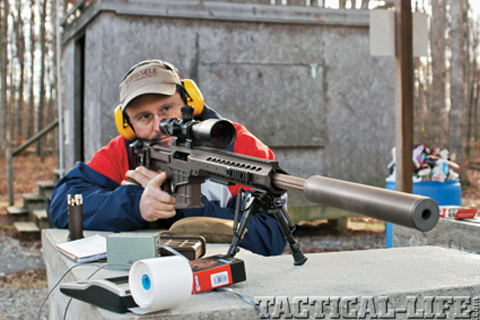
Made of a temperature-resistant polymer, the adjustable cheek piece also offers a consistent rifle-to-user contact point. The rifle’s length of pull can be set to five different positions with the push of a single button. From its quick-detach sling mounts to the Barrett Multi-Role Brown color of the rifle that blends into any environment—every detail of the MRAD has been carefully designed to create one thing: a high-performance rifle you can truly make your own.
Photos from tactical life
NEWS ARCHIVES


Multi-Role Adaptive Design rifle (MRAD)
Ready to follow your every move, the MRAD adapts to a variety of user needs without sacrificing performance. With unrelenting precision and unfailing accuracy, this bolt action newcomer has already defined a whole new class of long-range rifles.
The MRAD rifle’s user-changeable barrel system is just one example of this hardworking gun’s modularity. The precision-grade barrel can be removed by simply unscrewing two bolts using a standard Torx wrench. Besides reducing maintenance and logistical burdens, this unique design paves the way for future caliber interchangeability and serviceability.
The MRAD also boasts Barrett’s new easily accessed trigger module. This match-grade trigger is drop-fire-proof and combat-ready. The thumb-operated safety can be configured for left or right hand operation. The ambidextrous magazine release can be used intuitively while retaining a firing grip and cheek weld.



Integrated into the MRAD rifle’s 7000 series aluminum upper receiver is an M1913 rail with 30 MOA taper and 21.75 inches of rail space. The configurable side and bottom rails can also hold a number of accessories. The MRAD rifle’s stock is foldable for enhanced portability yet locks in as solid as a fixed-stock rifle, creating a rigid platform for consistent firing. When folded, the stock latches around the bolt handle for added security during transport. Because the stock folds to the bolt handle side of the action, the rifle is the same width overall, folded or extended.


Made of a temperature-resistant polymer, the adjustable cheek piece also offers a consistent rifle-to-user contact point. The rifle’s length of pull can be set to five different positions with the push of a single button. From its quick-detach sling mounts to the Barrett Multi-Role Brown color of the rifle that blends into any environment—every detail of the MRAD has been carefully designed to create one thing: a high-performance rifle you can truly make your own.
Photos from tactical life
NEWS ARCHIVES

2012年03月15日
.308 Perseus Precision
私たちのブログを訪問していただきありがとうございます。あなたがお持ちの場合DIYの要求は私達に電子メールを送信してください。
Underground Skunkworks’ rugged, surgical sniper with a 3/8-MOA guarantee!
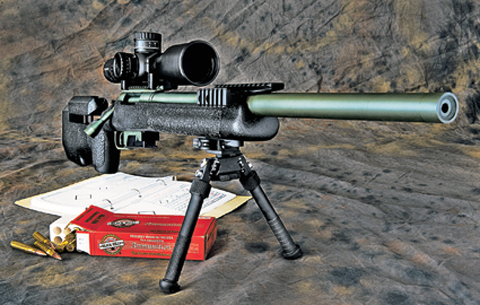
Hand finished from muzzle to receiver, the Perseus features an 11-degree recessed crown. Its threads are cut to within .0001-inch or less. With its adjustable Manners MCS-T4A stock, the precise and solidly built Perseus provides the shooter with an instantly stable and consistent firing platform.
In an age where new offerings come with equal parts marketing pitch and reductive disclaimers, it is a bit of a shock, at first, to encounter a rifle that not only shoots to its manufacturer’s claims, but exceeds them. The Columbia Falls, Montana, rifle company Underground Skunkworks, or UGSW for short, has produced what might be the finest production precision rifle on the market today—the Perseus. Designed for law enforcement missions requiring surgical engagements of targets, the Perseus is a rugged and reliable tool with razor-thin accuracy.

Sporting a custom-designed, Timney-made trigger, the Perseus’ 911 action can accept AW or AICS magazines and be topped off via the breech.
From his humble beginnings as an engineer, UGSW President and Founder Mike Bush has applied an obsessive attention to detail and practical design techniques to correct the flaws and enhance the strengths of the modern-era bolt-action precision rifle. Raised at his father’s elbow, who was a law enforcement officer, in their Mobile, Alabama, diesel shop, Bush went on to earn a degree in electronics engineering. With both a formal and practical education in engineering and design, Bush fostered a lifelong interest in perfecting mechanical precision and long-range shooting. Watching firsthand as FBI HRT shooters tested, broke, fixed and improved upon existing production rifles, Bush learned a crucial lesson in rifle design: “I was disappointed in what I saw as an across-the-board inconsistency in the tolerances of production rifles. Twist rates, fit and finish varied considerably within a single model produced in the same production run from the same factory.”
For the Perseus, Bush set out to design a duty rifle that modernized the M24/M40 platform, keeping what worked and eliminating what did not. “The core capability of this system had to provide both cold-bore and sustained-fire accuracy. There is little on the rifle that is not available somewhere on the open market, but the key is how the highest quality components are harmonized and fit.”
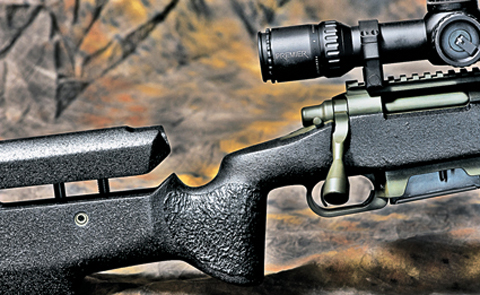
The Perseus features oversized bolt knobs and an Oberndorf-style mag release for fast handling in wet conditions or with gloved hands.
By Len Waldron, Images by Jeff Wiseman
BLOG ARCHIVES

Underground Skunkworks’ rugged, surgical sniper with a 3/8-MOA guarantee!

Hand finished from muzzle to receiver, the Perseus features an 11-degree recessed crown. Its threads are cut to within .0001-inch or less. With its adjustable Manners MCS-T4A stock, the precise and solidly built Perseus provides the shooter with an instantly stable and consistent firing platform.
In an age where new offerings come with equal parts marketing pitch and reductive disclaimers, it is a bit of a shock, at first, to encounter a rifle that not only shoots to its manufacturer’s claims, but exceeds them. The Columbia Falls, Montana, rifle company Underground Skunkworks, or UGSW for short, has produced what might be the finest production precision rifle on the market today—the Perseus. Designed for law enforcement missions requiring surgical engagements of targets, the Perseus is a rugged and reliable tool with razor-thin accuracy.

Sporting a custom-designed, Timney-made trigger, the Perseus’ 911 action can accept AW or AICS magazines and be topped off via the breech.
From his humble beginnings as an engineer, UGSW President and Founder Mike Bush has applied an obsessive attention to detail and practical design techniques to correct the flaws and enhance the strengths of the modern-era bolt-action precision rifle. Raised at his father’s elbow, who was a law enforcement officer, in their Mobile, Alabama, diesel shop, Bush went on to earn a degree in electronics engineering. With both a formal and practical education in engineering and design, Bush fostered a lifelong interest in perfecting mechanical precision and long-range shooting. Watching firsthand as FBI HRT shooters tested, broke, fixed and improved upon existing production rifles, Bush learned a crucial lesson in rifle design: “I was disappointed in what I saw as an across-the-board inconsistency in the tolerances of production rifles. Twist rates, fit and finish varied considerably within a single model produced in the same production run from the same factory.”
For the Perseus, Bush set out to design a duty rifle that modernized the M24/M40 platform, keeping what worked and eliminating what did not. “The core capability of this system had to provide both cold-bore and sustained-fire accuracy. There is little on the rifle that is not available somewhere on the open market, but the key is how the highest quality components are harmonized and fit.”

The Perseus features oversized bolt knobs and an Oberndorf-style mag release for fast handling in wet conditions or with gloved hands.
By Len Waldron, Images by Jeff Wiseman
BLOG ARCHIVES

2012年03月10日
Nemesis Vanquish
私たちのブログを訪問していただきありがとうございます。あなたがお持ちの場合DIYの要求は私達に電子メールを送信してください。
From up-armored briefcase to DOA precision in 60 seconds or less!

For many years, the .308 Winchester has been a major cartridge of choice for snipers. Combined with the Vanquish, the .308 Win. improves your odds for precise, long-range hits.
Since the American Revolution, our military has used the marksman, a sniper in today’s terminology, to great effect on the battlefield. It may not have been considered gentlemanly at the time, especially by the neat phalanxes of Redcoats who complained about the rebels fighting from behind concealment and cover like Indians, but the results would override any objections. By the American Civil War, the marksman was entrenched in the tactics of warfare with his properties of stealth and long-range accuracy. Enemies were no longer safe even far from the frontlines. Over time, the mission of the sniper has basically stayed the same, aside from also being tasked as a scout or observer because of his forward deployment, but there have been changes in both his methods and equipment. The most notable changes have been made to the sniper’s main weapon, the rifle.
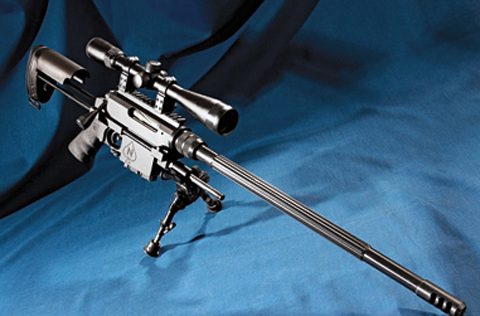
The Vanquish is a purpose-built rifle with all components tuned to provide the best function and accuracy. It may look stark, but it will bring out the best in the ammunition and the shooter.
The marksmen of the Revolution mainly used their personal firearms, most often hunting rifles, because they were more accurate than the military muskets of the day. Over the years, improvement to military arms has led to improvement in sporting arms and vice versa, to the point where the sniper’s rifle has usually been one of two types: either a sporting arm adapted to handle the rigors of the battlefield, or a military rifle modified to improve accuracy. Only towards the end of the 20th century did we see rifles that were purpose-built for use by the American sniper. I am not talking about the Remington 700s or the Winchester 70s, since these were sporting rifles at birth, but the larger .50-caliber rifles built by firms such as Barrett.
It is in this arena of modern weapons that Nemesis Arms has made a grand entrance with the manufacture of the Vanquish. The Vanquish is designed from the ground up as the ultimate mid-caliber weapon for the modern sniper.

The barrel is a slip-fit into the receiver and then held in place by a threaded nut. The spring-loaded plunger, seen below the threads, assures everything stays together.
By Terrill Hoffman, Images by Terril Hoffman
BLOG ARCHIVES

2012年03月08日
Magpulized Russian Dragunov (SVD) Rifle
私たちのブログを訪問していただきありがとうございます。あなたがお持ちの場合DIYの要求は私達に電子メールを送信してください。

The Magpul phenomenon has reached Russia. Gennady M. Kozhaev, gunsmith and owner of a OOO Skat, has developed a range of modernized SVD rifles. The rifles are build using Izhmash Tigr receivers and Lothar Walther barrels.

The rifle feature an AR-15 A2 pistol grip and a Magpul PRS stock. The redesigned handguard has a full length rail on top. Side rails and an under rail can be attached to the handguard.
The gas block has been redesigned and looks much more substantial than the original SVD design. Judging by the photos, the gas block may have an adjustable gas regulator. The Lothar Walther barrel is threaded with a muzzle brake, instead of the SVD / Tigr flash suppressor. Both front and rear iron sights have been removed.
Mr. Kozhaev has also developed a compact variant which features a shorter barrel, low profile gas block (so that it fits underneath the rail), ergonomic pistol grip and an original SVD side-folding stock.


Compact Modernized SVD
From thefirearmblog
BLOG ARCHIVES

2012年03月07日
Remington M40-XS .338 Lapua Magnum
私たちのブログを訪問していただきありがとうございます。あなたがお持ちの場合DIYの要求は私達に電子メールを送信してください。
Precision performance for the LE Designated Marksman with devastating punch!
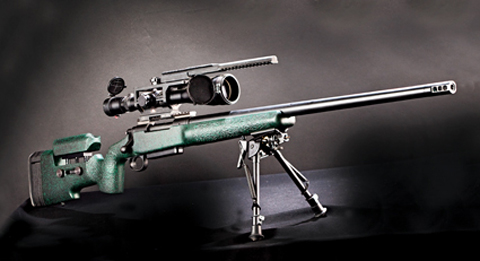
Remington 40-XS in .338 Lapua bridges the gap between .308 and .50 BMG in a state of the art bolt action rifle that delivers the goods in terms of both accuracy and terminal ballistics.
THE .338 Lapua Mag is a precision tactical cartridge whose time has come. Originally developed in 1983 at the request of the U.S. Navy, the .338 uses a necked down .416 Rigby case and in its initial configuration launched a 250-grain bullet at nearly 3,000 feet per second (fps) with a muzzle energy of over 4,800 foot pounds of energy (fpe). Research Armament produced a prototype rifle and ammunition that were tested by the Navy, but the cartridge never was put into production in the United States. Lapua and Norma finished development of the .338 and began manufacturing the cartridge under the Lapua name. Besides Lapua, Black Hills also loads both 250- and 300-grain cartridges. The latter bullet leaves the muzzle at 2,800 fps with a prodigious 5,223 fpe. To put this into perspective, a 168-grain .308 match cartridge has a muzzle velocity of only about 2,600 fps and 2,180 fpe. The .308’s ballistics pale in comparison to the .338 Lapua, although most .338 rifles are only marginally heavier than precision tactical rifles chambered for the .308.

When raised up, the McMillan A5’s adjustable cheekpiece is designed not to conflict with the “bolt throw” of the host rifle.
The Remington Model 40-XS, for example, is only slightly larger and heavier than similar rifles in smaller calibers, weighing in at 16 pounds — complete with scope and bipod. The test rifle uses Remington’s Model 40-XS action in a McMillan A5 stock. Naturally, a large cartridge like the .338 will necessarily deliver more felt recoil than lesser cartridges, but this can be offset by the use of muzzle brakes. The Remington muzzle brake reduces felt recoil to approximately that of a .308, although muzzle blast alongside the rifle is significant. The spotter on a precision tactical team using a Remington 40-XS .338 Lapua Mag should position himself slightly to the rear of the shooter’s shoulder to avoid having gases and dust blown into his face. As the .338 Lapua Mag became accepted by a number of the world’s military forces as replacements for, or supplements to bridge the gap between the .308 and .50 BMG, it was only a matter of time before law enforcement began to consider it. The .338 gives the precision tactical marksman a huge range advantage over any .308 caliber rifle, while adding little to the weight burden that every rifleman must contend with. As mentioned, the test rifle weighs only 16 pounds (fully loaded) and I’ve tested .308 caliber precision tactical rifles that weigh about the same. When compared to .50 BMG caliber rifles, the Remington 40-XS weighs nearly 10 pounds less than the lightest weight .50 BMG rifle I’ve ever tested. Most .50 BMG rifles, like the widely used Barrett M82, weigh over 30 pounds.

The aggressively designed muzzle brake of the 40-XS helped tame the recoil of the .338 Lapua Mag chambering down to manageable .308 levels.
By Tactical-Life.com, Images by Doug Richardson
BLOG ARCHIVES

2012年03月06日
JP Enterprises PSC-11 .223 WYLDE
私たちのブログを訪問していただきありがとうございます。あなたがお持ちの場合DIYの要求は私達に電子メールを送信してください。
Built and bred for battle—high-end match-grade combat rifle!

With a reputation like JP Enterprises’, the PSC-11 lives up to its predecessors’ ability for first-shot accuracy, and it definitely has the ability to pile bullets into tight groups when it runs hot, too.
When I first held JP Enterprises’ new PSC-11 rifle in my hands last year, my first thought was that somebody left one of their JPE CTR-02s and an LRP-07 in a dark corner of the shop, put on some mood music and let nature take its course. In reality, John Paul, the owner of JP Enterprises, listened to requests from shooters who wanted a high-quality, accurate AR upper to fit their lower receivers. It wasn’t too much of a stretch to take the best features of the LRP-07 and blend them with a CTR-02 to create the new rifle.

This JPE PSC-11 is tricked out with a 4.5-14x Leupold Mark 4, Accu-Shot’s high-grade monopod, Atlas bipod, and Magpul’s PRS buttstock, adjustable grip and magazine. The rifle’s .223 Wylde chambering lies between the .223 and 5.56mm NATO dimensions, boosting versatility.
“With the introduction of our new SCR-11 platform, we knew serious shooters would want to incorporate the JP side-charge system into their existing small-frame gas gun,” John Paul said. “That’s why we are introduced the new PSC-11 in 2011. This upper combines all the great features and performance of the new SCR-11 in a package that is cross-compatible with any standard lower receiver on the market. This new upper system is designed for the all-out tactical market with redundant side and top charging systems, dust cover, forward assist and an optional key-slot gas plug for those running suppressed systems.”

Shoulder-mounted charging is quick and easy with JPE’s side-charge system, but if you’re a traditionalist, it still has a standard AR charging handle.
By Jay Langston, images by Oleg Volk
BLOG ARCHIVES

2012年03月04日
Canadian .338 Timberwolf
私たちのブログを訪問していただきありがとうございます。あなたがお持ちの場合DIYの要求は私達に電子メールを送信してください。

Got your back! No two combat shots are ever the same and not always taken from a prone position. The advanced sniper course challenged the shooters with making shots with improvised rifle rests!
Canadian warriors have fought alongside American troops in the trenches of the Somme, the islands of Alaska during WW II, the beaches of Dieppe and Normandy, defending the Western Approaches, and from the frozen wastes of Korea, to the miserable jungles of Vietnam and the sands of Iraq. Canadian Forces, although fewer in numbers, have fielded professional and motivated warfighters since 1884 when the Canadian Army was founded in Fredericton, New Brunswick. Today, near that very spot where the first Canadian Infantry mustered, is the CFB (Canadian Forces Base) Gagetown, the largest of its kind in The Great White North.
CFB Gagetown is where new Officers and boots right out of basic training are taught the combat arms. Part of this small, efficient organization is the Combat Training Centre, Infantry School, Advanced Sniper Course that is offered once a year by the Infantry Training school’s Sniper Cell.

The PGW Timberwolf in .338 Lapua has been selected as the Canadian Force’s medium range precision-fire rifle.
Building The Best Snipers
To be selected for the Basic Sniper Course, the trainees must first go through a battalion-level course to qualify as a basic recon patrolman, apply to the sniper group and be screened by the UMS (Unit Master Sniper) via a physiological, legal and conduct evaluation before being invited to attend a two-week pre-course. Fourteen of 22 passed a recent pre-course, just to enter the eight-week, battalion level, basic sniper course. The sniper trainees are assessed every evolution, every day, so that the course has a very high failure rate; One course passed three trainees out of 14. The snipers are then assigned to an 18-man sniper group attached to each infantry battalion under a Warrant Officer who is the UMS. The group is further broken down into two, eight-man sections with four-man operational detachments or “dets.”
BLOG ARCHIVES


Got your back! No two combat shots are ever the same and not always taken from a prone position. The advanced sniper course challenged the shooters with making shots with improvised rifle rests!
Canadian warriors have fought alongside American troops in the trenches of the Somme, the islands of Alaska during WW II, the beaches of Dieppe and Normandy, defending the Western Approaches, and from the frozen wastes of Korea, to the miserable jungles of Vietnam and the sands of Iraq. Canadian Forces, although fewer in numbers, have fielded professional and motivated warfighters since 1884 when the Canadian Army was founded in Fredericton, New Brunswick. Today, near that very spot where the first Canadian Infantry mustered, is the CFB (Canadian Forces Base) Gagetown, the largest of its kind in The Great White North.
CFB Gagetown is where new Officers and boots right out of basic training are taught the combat arms. Part of this small, efficient organization is the Combat Training Centre, Infantry School, Advanced Sniper Course that is offered once a year by the Infantry Training school’s Sniper Cell.

The PGW Timberwolf in .338 Lapua has been selected as the Canadian Force’s medium range precision-fire rifle.
Building The Best Snipers
To be selected for the Basic Sniper Course, the trainees must first go through a battalion-level course to qualify as a basic recon patrolman, apply to the sniper group and be screened by the UMS (Unit Master Sniper) via a physiological, legal and conduct evaluation before being invited to attend a two-week pre-course. Fourteen of 22 passed a recent pre-course, just to enter the eight-week, battalion level, basic sniper course. The sniper trainees are assessed every evolution, every day, so that the course has a very high failure rate; One course passed three trainees out of 14. The snipers are then assigned to an 18-man sniper group attached to each infantry battalion under a Warrant Officer who is the UMS. The group is further broken down into two, eight-man sections with four-man operational detachments or “dets.”
BLOG ARCHIVES

2012年03月03日
Les Baer Custom Ultimate Match .308
私たちのブログを訪問していただきありがとうございます。あなたがお持ちの場合DIYの要求は私達に電子メールを送信してください。
Custom-crafted AR that enhances the effectiveness of the SWAT sniper!

The clean lines and simple elegance of the Les Baer Ultimate Match .308 are indicative of the precision that can be expected within. The rifle is shown with a Trijicon 5-20×50mm riflescope and a Harris bipod.
THE .308 HAS LONG BEEN one of my favorite cartridges. It’s efficient, it’s accurate and—whether you’re putting the crosshairs on a whitetail, an enemy combatant or dangerous felon—it can be deadly.
The new Ultimate Match .308 semi-auto is built like all Les Baer rifles. It’s a true custom weapon that’s hand built for a perfect fit, accuracy and reliability. Les Baer’s rifles are all about quality parts and thoughtful extra touches. The first time you take it to the range, Baer’s obsession with quality and attention to detail will become immediately apparent, due in large part to the LBC bench rest-quality 416R stainless steel barrel with cut rifling—a feature that has become a hallmark of all Les Baer Custom rifles.

This rifle’s 7075-T6-51 billet aluminum receiver is the most rigid material that Les Baer has found, primarily used in high-tech aviation. The large triggerguard’s dimensions are roomy enough to allow easy use of cold-weather mitts or tactical gloves without interference.
One of the primary features of the Ultimate .308 is that the upper and lower receivers are precision machined from 7075-T6-51 premium billet aluminum alloy. “This is the most stable aluminum that has ever been used on a firearm,” Baer said. “It’s used a lot in the aircraft industry. It does not move after you machine it. When we machined uppers or lowers out of other aluminum alloys, once you start machining a part it will start warping. We get zero movement on this material. When you take a piece of any other type of aluminum that’s 18 inches long and start taking material out, then it will start to move and warp. We’ve machined 7075-T6-51 every which way you can, and it’s the best we’ve used.”

The Ultimate Match’s 24-inch barrel’s 1-in-10-inch twist is perfect for stabilizing 168- to 178-grain match grade bullets.
By Jay Langston, Images by Steve Woods
BLOG ARCHIVES

Custom-crafted AR that enhances the effectiveness of the SWAT sniper!

The clean lines and simple elegance of the Les Baer Ultimate Match .308 are indicative of the precision that can be expected within. The rifle is shown with a Trijicon 5-20×50mm riflescope and a Harris bipod.
THE .308 HAS LONG BEEN one of my favorite cartridges. It’s efficient, it’s accurate and—whether you’re putting the crosshairs on a whitetail, an enemy combatant or dangerous felon—it can be deadly.
The new Ultimate Match .308 semi-auto is built like all Les Baer rifles. It’s a true custom weapon that’s hand built for a perfect fit, accuracy and reliability. Les Baer’s rifles are all about quality parts and thoughtful extra touches. The first time you take it to the range, Baer’s obsession with quality and attention to detail will become immediately apparent, due in large part to the LBC bench rest-quality 416R stainless steel barrel with cut rifling—a feature that has become a hallmark of all Les Baer Custom rifles.

This rifle’s 7075-T6-51 billet aluminum receiver is the most rigid material that Les Baer has found, primarily used in high-tech aviation. The large triggerguard’s dimensions are roomy enough to allow easy use of cold-weather mitts or tactical gloves without interference.
One of the primary features of the Ultimate .308 is that the upper and lower receivers are precision machined from 7075-T6-51 premium billet aluminum alloy. “This is the most stable aluminum that has ever been used on a firearm,” Baer said. “It’s used a lot in the aircraft industry. It does not move after you machine it. When we machined uppers or lowers out of other aluminum alloys, once you start machining a part it will start warping. We get zero movement on this material. When you take a piece of any other type of aluminum that’s 18 inches long and start taking material out, then it will start to move and warp. We’ve machined 7075-T6-51 every which way you can, and it’s the best we’ve used.”

The Ultimate Match’s 24-inch barrel’s 1-in-10-inch twist is perfect for stabilizing 168- to 178-grain match grade bullets.
By Jay Langston, Images by Steve Woods
BLOG ARCHIVES

2012年03月03日
Thor XM408
私たちのブログを訪問していただきありがとうございます。あなたがお持ちの場合DIYの要求は私達に電子メールを送信してください。
The modular tactical rifle ready for military and LE hard-target, 2,000-plus yard duty!

The Thor XM408, chambered in the extremely powerful .408 Chey Tac cartridge, offers shooters a long-range precision rifle with 2,000-yard capability in a package that weighs less than comparable .50 BMG rifles. It also breaks down easily for transportation.
The .408 Cheyenne Tactical (.408 Chey Tac) cartridge is a military and LE long-range precision tactical cartridge whose time may well have come. The original round was developed by Dr. John Taylor and William Wordman in the United States in 2001 to provide a precision tactical cartridge with precision accuracy out to 2,000 yards. The .408 Chey Tac essentially uses a modified and necked down .505 Gibbs case and launches either a 305-grain bullet at 3,500 FPS (feet per second) or a 419-grain bullet at 3,000 FPS with a muzzle energy of more than 8,000 ft-lbs (foot pounds). By comparison, a 168 grain .308 match cartridge has a muzzle velocity of only approximately 2,600 fps and 2,180 ft-lbs energy. The .308 is totally overshadowed by the .408 Chey Tac, although our Thor XM408 test rifle was only marginally heavier than precision tactical rifles chambered for the .308.
Anti Materiel Role

The Thor XM408 employs a robust action made from steel and feeds from a detachable box magazine. Note the spiral grooves on the body of the rifle’s bolt.
The .408 Chey Tac is intended not only for antipersonnel purposes, but for antisniper and antimateriel use, as well. Naturally, a large cartridge like the .408 Chey Tac will deliver more felt recoil than lesser cartridges, but this can be offset by the use of muzzle brakes. The Thor XM408 brake reduces felt recoil to approximately that of a .308, although muzzle blast alongside the rifle is pronounced and distracting. The spotter on a precision tactical team using an XM408 should position himself slightly to the rear of the shooter’s shoulder to avoid having gases blown into his face.
Built For Duty

The XM408’s stock is fully adjustable for both length of pull and cheekrest height, making it infinitely adaptable to a wide range of tactical operators.
By Charlie Cutshaw. Images by Doug Richardson
BLOG ARCHIVES

2012年03月02日
Urban-Ops Sureshot
私たちのブログを訪問していただきありがとうございます。あなたがお持ちの場合DIYの要求は私達に電子メールを送信してください。
Short on size, long on performance, CZ’s new Urban Counter Sniper

Designed for urban sniper applications, the CZ UCS’s 37-inch overall length made getting into a final shooting position more than manageable by anyone’s standards.
Ceska Zbrojovka, or CZ, has been making weapons for military, police and sportsmen from their headquarters in the former Czechoslovakia since 1936. Their CZ-75 pistol and Vz-58 Assault rifles are known worldwide for their reliability and accuracy. On the sporting fields and the games plains of Africa, the controlled-round-feed bolt- action 550 rifles manufactured by CZ have been the first choice of working professional hunters for more than 60 years. The company took that experience and put it into the bolt-action Model 550 Urban Counter Sniper, designed from the ground up to fill the military and police marksman’s requirements.

Smooth operation! Engineers at CZ were using their proverbial heads! The bolt on the CZ-USA’s Urban Counter Sniper is controlled round feed—capturing the round as it strips it out of the magazine.
550 UCS Lineage
The 550 UCS is chambered for the .308 Winchester/7.62mm NATO cartridge and is directly descended from the CZ 750 S1M1 Sniper rifle. The CZ 750 is fielded with a hammer-forged 26-inch barrel housed in a synthetic thumbhole stock with an adjustable cheek rest. As with most modern military tactical bolt guns, the underside of the fore-end is fitted with a rail that provides multiple attachment points for a bipod, and the rifle also features a muzzle brake, thread protector, mirage shield and two 10-round detachable magazines. The 12-pound CZ 750 Sniper will reach out to targets in excess of 800 yards. It is the current issue .308-caliber long arm of the Spanish Municipal Police, the Slovakian Ministry of the Interior, and Mexican National Defense Forces.

Excellent ergonomics of the 16-inch barreled Urban Counter Sniper were matched by sub-MOA accuracy during testing.
CZ On Duty
In Spain, cities with less than 5,000 residents usually don’t have their own organized police force. These towns and cities are served by the Policia Municipale. The Municipal police wear blue uniforms and patrol in white or blue cars and up-armored HUMVEES. Municipal Police jurisdiction extends from minor crime such as traffic control and protection of property, to the civil disturbances so common in European countries. In Spain’s resort areas, they usually find themselves dealing with misbehaving tourists, but last year broke up an arms-trafficking ring on the Island of Majorca where they recovered 300 weapons including machine guns and grenade launchers, as well as a seven-man Al-Qaida cell working out of Barcelona.
By John Fasano, Images by Ichiro Nagata
BLOG ARCHIVES

2012年03月01日
.50 BMGs Battle
私たちのブログを訪問していただきありがとうございます。あなたがお持ちの場合DIYの要求は私達に電子メールを送信してください。
Air Force snipers help TW find the big bore that packs all the right punch!

Barrett’s M107 operating system allows the rifle to function reliably in the harshest environments. U.S. Marine Corps Sgt. Daniel Price, left, a team leader with 3rd Platoon, Alpha Company, 1st Marine Reconnaissance Battalion, 13th Marine Expeditionary Unit, spots impacts down range for Gunnery Sgt. David Lind, a platoon sergeant with 3rd Platoon, Alpha Company, 1st Marine Reconnaissance Battalion, 13th Marine Expeditionary Unit, while he zeros his .50-caliber M107 special applications scoped rifle from an unknown distance on Udari range, Kuwait. (U.S. Marine Corps photo by Lance Cpl. Kyle J. Keathley) (Released)
Bushmaster BA50
Bushmaster entered into the .50 BMG realm a few years ago by offering the BA50. Just like every precision bolt-action .50 BMG rifle on the market, the BA50 is built to tolerances and specifications that allow sub-MOA capabilities. Its overall length is 58 inches, and the rifle weighs in at 33 pounds with a 30-inch Lothar Walther barrel and 10-round magazine. The muzzle velocity averages 2,945 FPS with standard military M33 ball ammunition with 661-grain projectiles, and the rifle comes with a full-length Picatinny rail that runs the entire length of the forearm to accommodate night optics. Assembly of the BA50 is one of the simplest on the market for dedicated bolt-action .50 BMG rifles. Similar to the AR design, the upper receiver locks on to the lower receiver with two pins integral to the lower receiver.
The BA50 is hammer-fired, similar to the AR design, easing maintenance and aiding in reliability. Accuracy relies heavily on locking consistency and support of the cartridge and projectile. Tighter tolerances in the chamber area allow for a more consistent expansion of the cartridge as the powders ignite. The BA50 allows for a higher accuracy standard with a more modular chassis.
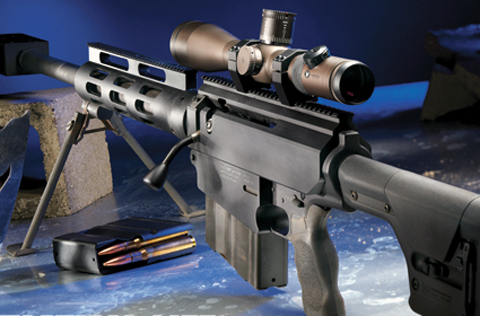
With high-quality glass mounted on Bushmaster’s .50-caliber beast, it’s a machine ready for anti-materiel and EOD disposal missions.
Barrett’s .50 BMG
Currently, the only mainstream, widely used semi-automatic, shoulder-fired .50 BMG rifle is the Barrett M82A1/M107. The weapon system functions via a short recoil operating system, similar to the Browning M2 machine gun chambered in the same cartridge. This creates an excessive amount of movement in the rifle, lowering the accuracy expectations to 2.5 MOA (or larger depending on how the firing position is set up). But it does utilize a 10-round magazine, allowing for a higher rate of fire, and has been proven to be extremely reliable in rugged environments. Military units around the world run this rifle platform and it has been extremely effective on the battlefields of Afghanistan and Iraq.

Designed for sub-MOA accuracy and with tight tolerances, the bolt-action Bushmaster BA50 is a very capable sniper rifle.
By Jon Weiler
BLOG ARCHIVES

2012年02月29日
KAC’s SR-25 U.S. SPEC OPS
私たちのブログを訪問していただきありがとうございます。あなたがお持ちの場合DIYの要求は私達に電子メールを送信してください。
With the BulletFlight iPod app, marksmen have 900M, cold-bore accuracy in the palm of their hands!
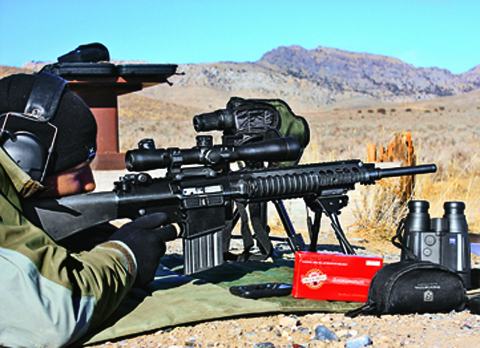
The semi-automatic action allows operators to engage multiple targets. Its similarity in appearance to a standard M-16 diminishes the likelihood of an enemy’s observation of a sniper’s presence during insertions with friendly patrols.
The SR-25 is the weapon platform that ushered in, or was rather a product of, a paradigm shift in the U.S. military’s thinking on sniper weapons. KAC’s (Knight’s Armament Company) SR-25 system has come to the battlefield and provides U.S. Special Operations Forces an accurate, semi-automatic platform with bolt-gun accuracy on multiple targets out to 800 meters, and eliminates the need for snipers to carry a defensive second rifle. Built into the familiar Stoner/AR design, the SR-25 can deliver five shots in five seconds and carries a 20-round magazine, thus surpassing the bolt-action rifle in both rate and duration of fire.
Chambered for the 7.62×51mm (.308) round, the SR-25’s design is both an extension of existing weapons development and a radical step forward. To support and extend the rifle’s battlefield sustainability, 60% of the parts are interchangeable with the AR-15/M16 system. Significant changes begin with the free-floating, match grade barrel that is now delivered in a 20-inch Obermeyer steel alloy and 16-inch chrome plated versions capable of sustained .5 MOA accuracy. The rotating bolt and direct-impingement gas system is based on Eugene Stoner’s designs and evolved further by C. Reed Knight, Jr. In order to both protect the free-floating barrel and accommodate sighting and rail mounted devices, KAC developed the Rail Adapter System II Upper Receiver Extension (RASIIURX). While slight variations exist between the Army, Navy and Marine Corp packages, the SR-25 system is typically outfitted with the 3.5-10×40mm Leupold Mk IV mil-dot scope, Harris bipod and KAC QD suppressor. Variants delivered to U.S. forces include more than 3,000 of the U.S. Army’s M110 SASS (Semi-Automatic Sniper System) and the 3,500 of U.S. Navy’s and Marine Corp’s Mk 11 Mod 0, 1&2. These deliveries are not only for use in the scout/sniper ranks, but are also finding themselves in the grateful hands of an increasing number of Designated Marksmen. Other branches of the U.S. government including the Department of State and Department of Energy have also adopted versions for their respective missions. Both in the hands of the trained sniper and the Designated Marksman, the SR-25 variants have seen direct action with Allied forces for more than six years. David Jones, a retired SEAL sniper who carried the Mk11 Mod 0 throughout two tours in Afghanistan, consistently had 1MOA accuracy out to 1,100 yards.
By Len Waldron, Images by Ichiro Nagata
BLOG ARCHIVES




